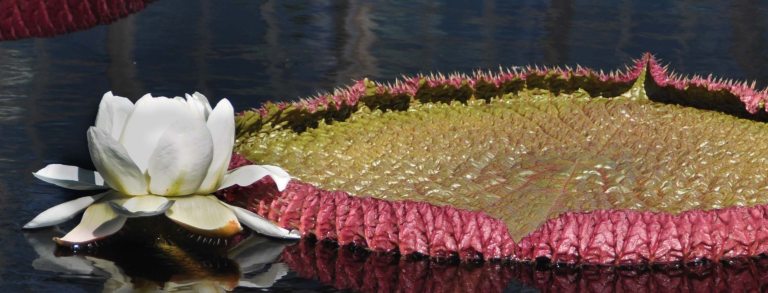Breeding and plant releasing started soon after Longwood became a public garden. Some plants have been developed by breeding projects undertaken by us, and others have been developed and/or released in conjunction with our plant exploration program.
Breeding projects aim at creating superior plant varieties, while focusing on optimizing flower production and drawing out recessive traits to create a striking new cultivar. Today, outstanding cultivars are continually being selected and regularly introduced.
Buxus sempervirens ‘Longwood’
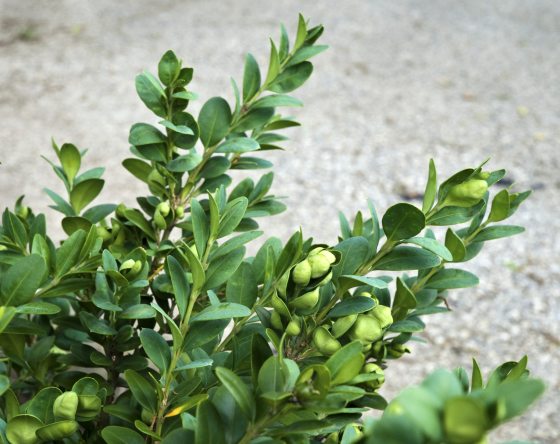
This plant was growing on Longwood property when Pierre S. du Pont purchased it in 1906, but it was not until nearly a century later that its outstanding form was recognized. The parent plant is twelve feet tall after more than 100 years and exhibits a densely-branched, nearly perfect round growth habit. The beautiful dark green foliage continues to darken throughout winter without the browning common to many boxwoods in colder climates, and contrasts exceptionally well with its red overwintering buds. This cultivar has proven extremely tolerant of drought, cold and other environmental stresses and is hardy to at least zone 6.
Camellia japonica ‘Longwood Centennial’

Selected among seedlings grown from seed collected on the 1984 expedition to Sochong Island in the Yellow Sea off the northeast coast of South Korea. A small number of seedlings proved to be hardy outdoors at (USDA zone 6) for more than 20 years. ‘Longwood Centennial’ was selected because of its exceptionally handsome, glossy foliage and dense, full growth habit. The cultivar may reach twelve feet in 20 years and is an excellent broad-leaved evergreen for areas where temperatures stay above -11.2 degrees Fahrenheit. Its flowers are red and typical of the species.
Camellia japonica ‘Longwood Valentine’
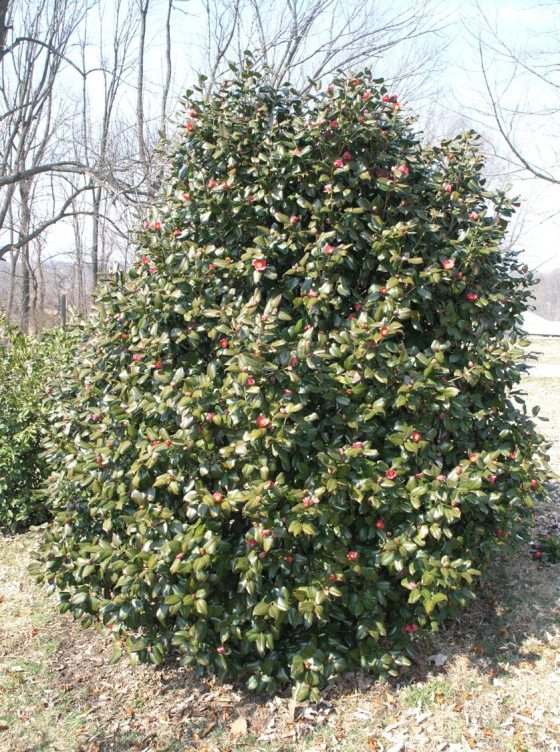
Selected among seedlings grown from seed collected on the 1984 expedition to Sochong Island in the Yellow Sea off the northeast coast of South Korea. A small number of seedlings proved to be hardy outdoors at Longwood Gardens (USDA zone 6) for more than 20 years. Reaching twelve feet in 20 years, ‘Longwood Valentine’ is the most floriferous of all the camellias collected in the 1984 expedition. Flowering typically occurs in early to mid spring, but in warm winters, flowers may open as early as January and continue through April. Flowers are red, slightly larger and more widely open than is typical for the species.
Caryopteris incana ‘Blue Billows’
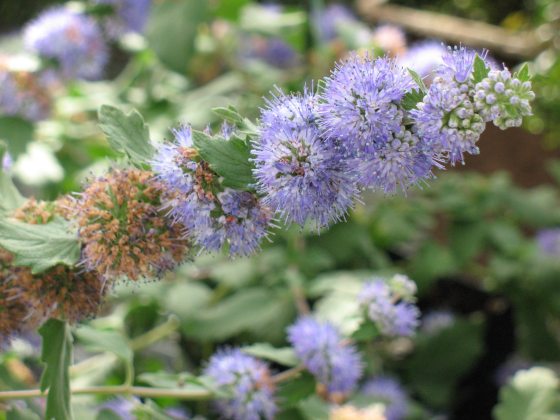
This cultivar is a low, compact, trailing form with a unique history linked to Longwood Gardens. The original plant specimen was found by two of Longwood Gardens’ plant explorers, Edward G. Corbett and Richard W. Lighty, along the beach on Cheju Island in Korea. Its form caught the keen eyes of these explorers who noticed its prostrate stems which arch upward at the tips displaying tight clusters of soft blue flowers. This cultivar attains heights of one foot with a larger spread and flowers from late summer into autumn on current season’s growth. The blue flowers are also an excellent late-season butterfly nectar source. This cultivar’s size, silvery-aromatic foliage and attractive late season blue flowers make this plant an ideal addition to any late summer, early fall garden. USDA zone 7 or 6 with protection.
Viburnum nudum ‘Longwood’
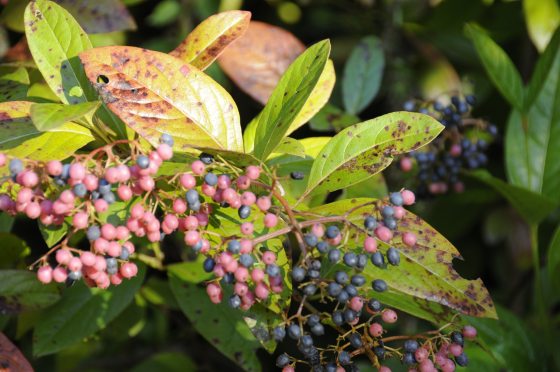
Named at Longwood Gardens, but of the same provenance as famed ‘Winterthur’. Viburnum nudum 'Longwood' was released to nurseries in 2008 for the first time! The selection has a compact, dense growth habit (five feet in height after 15 years), a prolific fruit set and handsome glossy foliage turning bright wine-red in the fall. Its ability to thrive in the Longwood Gardens visitor center parking lot for 15 years proves its adaptability and tough nature (USDA zone 6).
Longwood Highlighted Genera
Longwood Cannas (Canna)
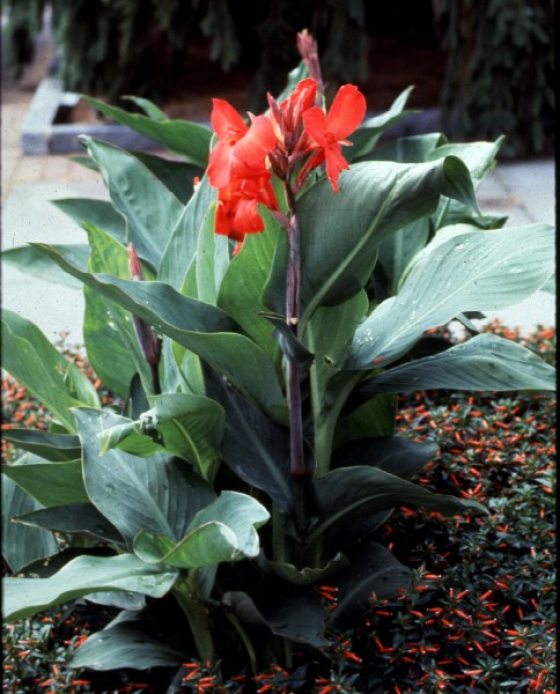
Prior to the 1960s, cannas were used primarily in formal Victorian gardens. There were few color choices, and they generally grew to six feet or taller. Dr. Robert Armstrong, Longwood’s Geneticist, began the canna breeding program in 1967, when it was realized that cultivars available at that time were not suitable for use on display in the Gardens. The original goal was to develop a clear yellow-flowered dwarf canna and a pure white-flowered canna that could grow well in the Conservatory. The project started with making crosses involving three cultivars, ‘Ambassador’, ‘Moonlight’, and ‘Banner’, which were obtained from Yalta, Ukraine and South Africa. As the project progressed, other cultivars and species were introduced from around the world. Seeds of five species were received from Lago Maggiore, Italy, Canna glauca was procured from Rio de Janeiro, Brazil, and in 1972, Dr. John Creech of the US National Arboretum, added three Russian cultivars, ‘K.A. Timirazov’, ‘Krimsky Riviera’, and ‘Soleznaya Krasavaya’. With the new additions to the breeding stock, red, orange and pink cannas were developed for the Conservatory along with the original white and yellow. The selection criteria used were plant vigor, early flowering, foliar appearance, self-cleaning ability and good propagation qualities. Between 1972 and 1985, twelve cultivars were selected for release. Named for local historically significant places and events, they were: ‘Brandywine’, ‘Chesapeake’, ‘Conestoga’, ‘Constitution’, ‘Declaration’, ‘Delaware’, ‘Franklin’, ‘Freedom’, ‘Independence’, ‘Liberty’, ‘Lenape’ and ‘Penn’.
Another project was to breed aquatic cannas. Canna glauca, which has roots that tolerate being submerged in water, was crossed with the terrestrial hybrids. Four cultivars, ‘Endeavour’, ‘Erebus’, ‘Ra’ and ‘Taney’, all named after famous ships, were selected in 1972. In 1990, Hawaiian-themed cultivars ‘Aloha’ and ‘Pele’ were released. Today at Longwood, cannas are used extensively in the Conservatory, Flower Garden Walk and Idea Garden.
Longwood New Guinea Impatiens (Impatiens mooreana, Impatiens herzogii, Impatiens linearifolia, Impatiens schlechteri)
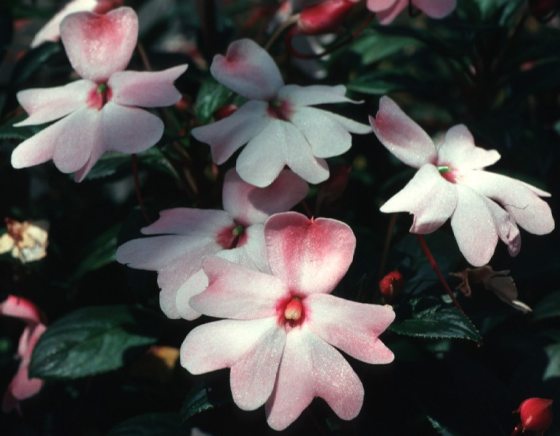
New Guinea Impatiens were originally discovered in the late 1800s. They were introduced into the US in 1970, when Longwood Gardens and the US Department of Agriculture (USDA) made a joint plant-collecting trip to New Guinea. Longwood funding provided the opportunity for Dr. Harold Winters and Dr. Joseph Higgins of the USDA to spend about 3 months in New Guinea collecting plants. The main goal was to collect tropical rhododendron species, but there were many other plants on their list, including impatiens. They found an enormous variety of impatiens all over the country and were able to transport some back to the US. Dr. Robert Armstrong, Geneticist at Longwood Gardens, received samples of the collected plants and began a breeding program. Some crosses were made to increase flowering and to find the best flower color and foliage.
In 1974, Longwood distributed the Circus series, which included 10 cultivars, ‘Bozo’, ‘Carousel’, ‘Harlequin’, Cotton Candy’, ‘Lollipop’, ‘Big Top’, ‘Charmer’, ‘Orange Crush’, ‘Painted Lady’ and ‘Stop Light’. These cultivars were selected mainly for their flower color, floriferousness, and good quality foliage. Subsequently, more cultivars were developed in the Circus series, which included ‘Calliope’, ‘Cannonball’, ‘Fortune Teller’, ‘Chariot’, ‘Juggler’, ‘Magician’, ‘Ringmaster’, ‘Roustabout’, ‘Showboat’, ‘Trapeze’, ‘Carnival’, ‘Headliner’, ‘Majorette’, ‘Roller Coaster’, ‘Ringmaster Improved’ and ‘Skyrocket’. Longwood ended this breeding program in 1978, because by then many commercial growers began working on impatiens breeding and there was no need to duplicate these breeding efforts. Although the original selections of Longwood’s impatiens are not generally used in the Gardens currently, newer varieties of New Guinea Impatiens can be found each summer in the Idea Garden.
Hollies (Ilex)
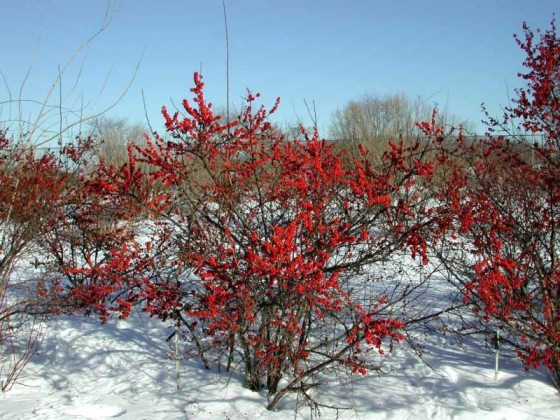
Hollies have been an important part of Longwood Gardens since the time of founder Pierre S. du Pont. From the beginning, he collected interesting specimens. This tradition has been continued by Longwood’s staff through seed exchanges with neighboring gardens and plant exploration around the world. Longwood currently has 274 active holly accessions in the garden.
Ilex opaca ‘Longwood Gardens’
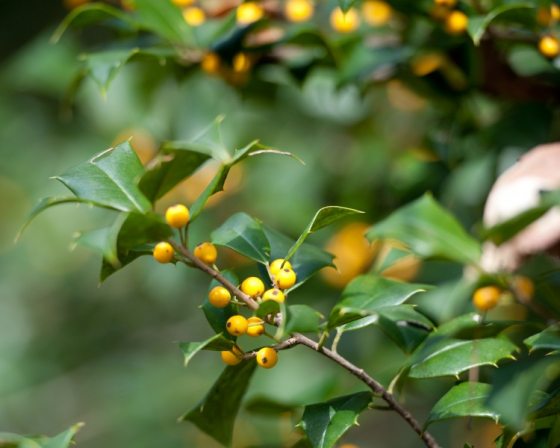
Pierre S. du Pont, Longwood’s founder, collected plants that added distinctive touches to the garden. Mr. du Pont’s brother-in-law, F. L. Belin, purchased several yellow-berried American hollies (Ilex opaca) from an unknown man. Upon seeing these plants in Mr. Belin’s garden, Mr. du Pont liked them so much and requested some be sent to him. Subsequently, one of the larger hollies was transplanted to Longwood. This plant is now located on the east side of the Open Air Theatre. 'Longwood Gardens' can also be found in the Idea Garden and near the Terrace Restaurant. Mr. du Pont made cuttings available to nurseries and this form of Ilex opaca named ‘Longwood Gardens’ has been available in the nursery trade since the 1950s.
Ilex × attenuata ‘Longwood Gold’
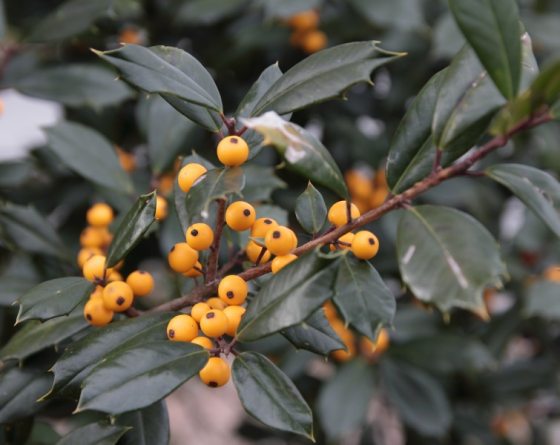
Longwood originally received this yellow-berried holly in the early 1970s as an open-pollinated seed from Morris Arboretum in Philadelphia. The plant was obtained believing that it was a rare holly species, Ilex forrestii, native to East Tibet and China. When this plant was grown, it was identified as Ilex × attenuata, a natural hybrid of two North American species (Ilex opaca and Ilex cassine). Morris Arboretum later re-identified the tree from which the seed was collected as Ilex × attenuata ‘Fosteri’. They suspect that it was a simple typing error that changed the name to Ilex forrestii. One of the plants grown from the seed received from Morris Arboretum turned out to have yellow fruit and Longwood selected this plant in 1976 for its fruit color and superior cold tolerance.
Ilex serrata ‘Longwood Firefall’

This red-berried shrub has a small form, growing to about 6’ tall, and gives a spectacular show of color in the fall. Obtained by Rick Darke, then Curator of Longwood Gardens, and Sylvester March of the US National Arboretum in 1985 from Shimabichi Nursery in Kawaguchi, Honshu, Japan. Selected for its semi-pendulous habit, it was named and introduced by Longwood Gardens. This plant was distributed in 1999 to nurseries and is commercially available.
Clivia miniata ‘Sir John Thouron’
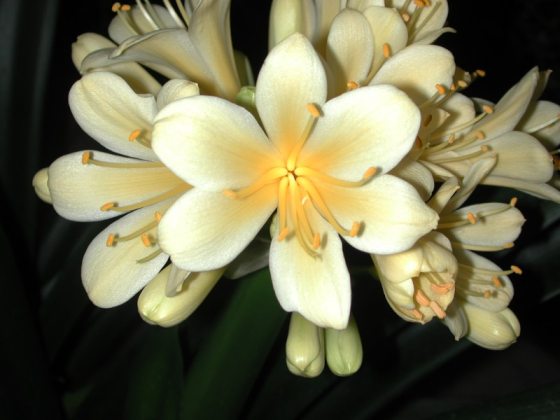
This rare yellow-flowered clivia was named for Sir John Thouron, who gardened at Glencoe Farms in Pennsylvania. Sir John received this plant from Queen Elizabeth II in Scotland many years ago and brought it to Philadelphia in the 1950s. Longwood Gardens facilitated the naming of the cultivar and distribution of this plant. In the early 1990s, White Flower Farm, a retail mail-order company in Connecticut, made the first commercial offering of this clivia and sold 36 plants for $950 each. On several occasions, a plant has been in the annual Rare Plant Auction held by the Delaware Center for Horticulture, and it has raised over $1,000 each time. Mrs. Lammot du Pont Copeland entered one in the Philadelphia Flower Show in 1999 and received the Pennsylvania Horticultural Society award of the highest-scoring blue ribbon entry. Longwood continues breeding this plant to find a double-flowered clivia.
Corylopsis glabrescens ‘Longwood Chimes’

In 1983, Dr. Clifford Parks of the University of North Carolina at Chapel Hill collected seeds of Corylopsis glabrescens on the Ebino Highland in southern Kyushu, Japan. The seeds were then distributed to the US National Arboretum and in 1985 Longwood Gardens received three seedlings from that Arboretum. Of these three, one seedling was selected as an outstanding specimen for the Gardens, because it has flowers and inflorescences larger than typical for this species. Its flowers are exceptionally fragrant and open about two weeks later than most other corylopsis. This cultivar was named ‘Longwood Chimes’ because the original specimen grows near the Chimes Tower in the Gardens. At an auction at Philadelphia's Morris Arboretum, this plant was up for bidding as a Garden Treasure. This plant has been distributed to nurseries in 1999 and is commercially available.
Magnolia acuminata var. subcordata ‘Peirce's Park’

A yellow-flowered magnolia, known as Magnolia cordata was planted on the Peirce farm (what later became Longwood Gardens) by Joshua and Samuel Peirce. This magnolia was discovered in 1788 by French explorer André Michaux in South Carolina. Michaux was the author of one of the first floras of North America and was one of the first trained botanists to explore and collect plant specimens in the Southern Appalachian Mountain region. The Peirce brothers most likely procured this magnolia from Michaux, with the help of either John Bartram or William Hamilton, owners of two prominent Philadelphia gardens. The tree still stands at Longwood Gardens, south of the Peirce du Pont house, and is a national champion at about 100’ tall. This clone was given a cultivar status because of its historical significance. This plant was distributed to nurseries in 1998 and is commercially available.
Rhododendron ‘Pierre du Pont’
In 1927, Pierre S. du Pont, founder of Longwood Gardens, constructed a greenhouse on the present site of the East Conservatory to house Mr. du Pont’s collection of azaleas and rhododendrons. There were two major collections, the first, one of the largest and finest collections of Belgium azaleas in the country; and the second, a rhododendron and azalea collection previously belonging to Professor Charles Sprague Sargent, Director (from 1873 to 1927) of the Arnold Arboretum in Boston. The two collections were found among other rhododendrons and azaleas that du Pont had obtained. This greenhouse was known as the Azalea House and sheltered the azalea collection until it was replaced by the current East Conservatory.
Sorbus rufoferruginea ‘Longwood Sunset’
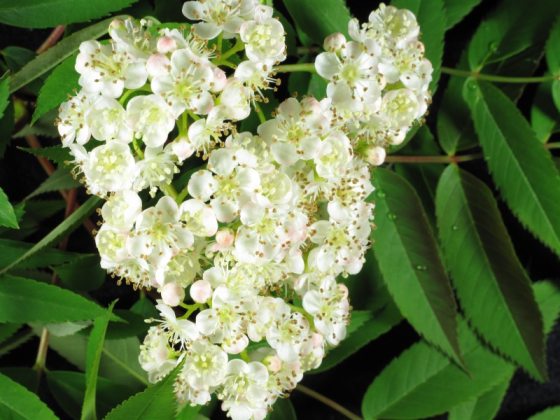
In 1964, Longwood received a seed of this plant from Mrs. Polly Hill of Martha’s Vineyard, Massachusetts. Mrs. Hill originally received the seed from Dr. Tsuneshige Rokujo, of Tokyo, Japan, who had collected the seed from a tree in cultivation there. In the 1950s, Mrs. Hill founded an arboretum in West Tisbury, on Martha’s Vineyard, known today as Polly Hill Arboretum. Over the years, Mrs. Hill selected outstanding cultivars, many of which have been released into the nursery trade. This mountain-ash cultivar was selected from among seedlings grown at Longwood. It is remarkable because of its heat tolerance. It is one of the few Sorbus that does well in the humid summers of Southeastern Pennsylvania. The name of this cultivar refers to its spectacular fall color.
Wisteria frutescens ‘Longwood Purple’
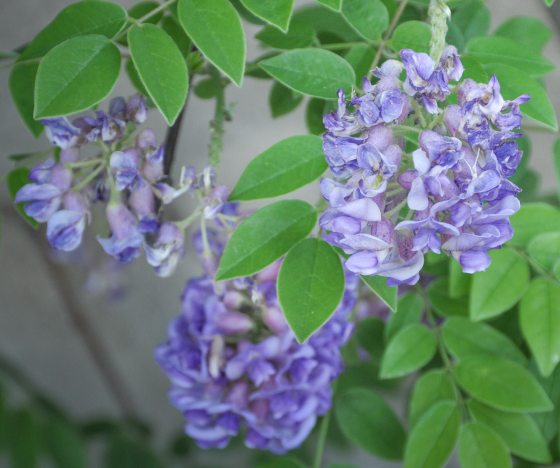
This wisteria, obtained by founder Pierre S. du Pont, grew near the entrance to Longwood's Conservatory for many years. Mr. du Pont planted many wisterias and it is speculated that this was his favorite, as it is one of the few remaining in the Gardens today. The 5"-long pendulous flowers are a deep purple color and bloom in summer to early fall. This plant was selected because it has flowers that are darker purple than typical for the species. It has been distributed to nurseries and is commercially available.
Victoria ‘Longwood Hybrid’
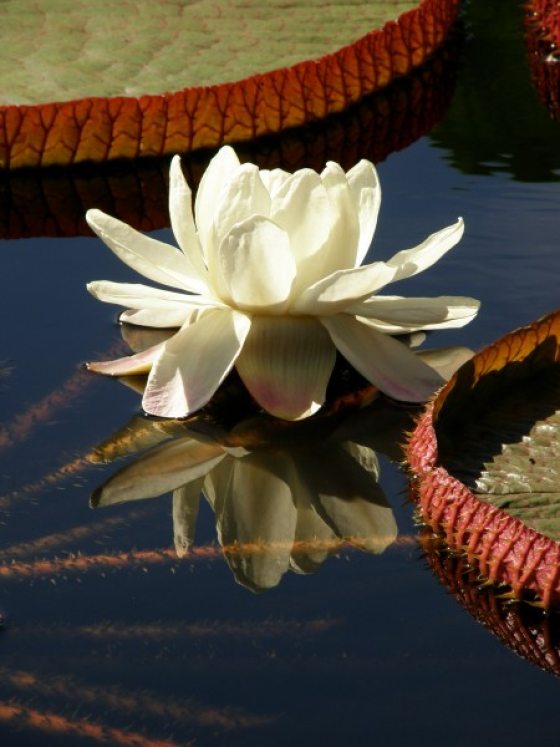
The Victoria water-platters, named for the British queen, are native to South America. Victoria amazonica is found in the Amazon River and Victoria cruziana grows in the Parana River and other cooler rivers further south. In 1960, Patrick Nutt, in charge of Longwood's aquatic display at that time, made crosses between the two water-platter species. The final selection showed extreme hybrid vigor, with leaves growing to 5’ or 6’ in diameter. It also had darker green leaves, higher leaf margins, larger and more numerous flowers, and it was as hardy as V. cruziana, the hardier of the two parents. This cultivar is not available commercially, but can be found on display at botanical gardens around the world, including in England, Japan, and the United States.
Buxus sempervirens ‘Belleville’

Boxwood is an important element in Victorian garden design. From the beginning, Longwood has selected excellent boxwood specimens for the Gardens and for distribution into the nursery trade. The search for new and better boxwood continues as plants are collected and obtained from around the world. Mrs. Erwin W. Seibert obtained Buxus sempervirens ‘Belleville’ from Mr. Nick Bassler, a nurseryman near Belleville, Illinois, in 1931; her son, Dr. Russell J. Seibert, named it and brought it to Longwood during his tenure as the Gardens' first director. The original plant at Belleville was growing one-half mile south of Scott Air Force Base. Selected for its cold tolerance, this Buxus is known for its dense, globular shape, and rich green-colored foliage. This boxwood is used in hedges in several places in Longwood Gardens including the Idea Garden and near the Open Air Theatre. This plant was distributed to nurseries in 1964 and is commercially available.
Camellia × williamsii ‘Aida’
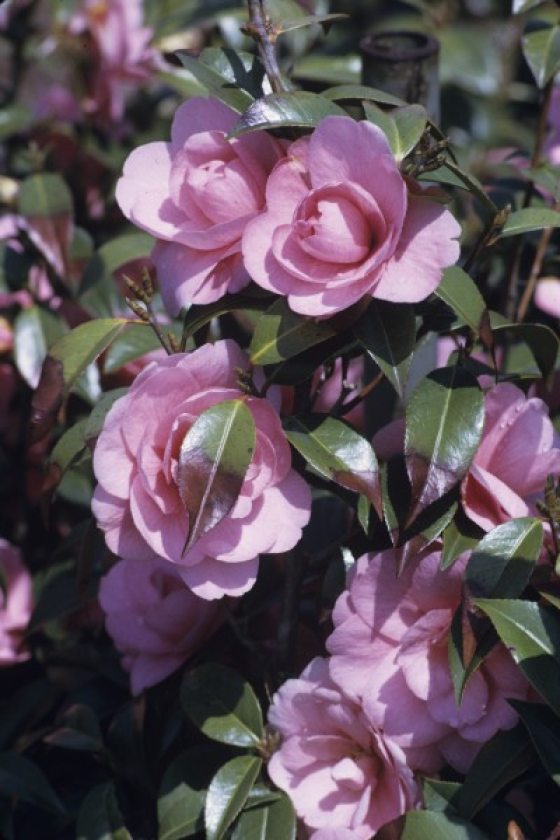
Pierre S. du Pont, Longwood’s founder, had an interest in camellias and started collecting them in 1912. He collected from many places, including importing them from France in 1916. They became a major component of the Conservatory and remain an important element of the present display. The camellia breeding project began at Longwood in the 1960s. Its main objective was to develop camellias that are reliably hardy outdoors in southeastern Pennsylvania. Dr. Clifford Parks, then with Los Angeles County Arboretum, in collaboration with Longwood Gardens, made the first crosses for the project in 1961. The plants were trialed at Longwood Gardens in an open plot in the nursery. Many were eliminated due to winter injury. ‘Aida’ was the only camellia trialed in the 1970s that survived two harsh winters, where the temperatures were close to 0ºF. ‘Aida’ originated from a seedling of a cross between C. japonica 'Ville de Nantes' and C. saluenensis 'Dogrose' and was received from Dr. Clifford Parks around 1968. Dr. Robert Armstrong, Longwood’s Geneticist, made the selection in 1974. The camellia breeding project continues at Longwood today. Although Camellia × williamsii ‘Aida’ cannot be seen on display, many other camellias are grown in the East Conservatory.
Hypericum frondosum ‘Sunburst’
Researchers at Cornell University, in Ithaca, NY, had been working on artificially induced tetraploid plants for many years. They induced tetraploidy in Hypericum in the late 1930s or 1940s. Dr. Richard Lighty, Longwood’s Geneticist in the 1960s, worked on this project as a graduate student at Cornell. The release of Hypericum ‘Sunburst’ was a joint project of Dr. Richard Lighty of Longwood Gardens and Dr. Robert Plaisted, Head of the Department of Plant Breeding at Cornell University. It was introduced and distributed by Longwood Gardens in the 1960s. This plant has been commercially available since then and has recently gained broad popularity.
Mandevilla ‘Alice du Pont’
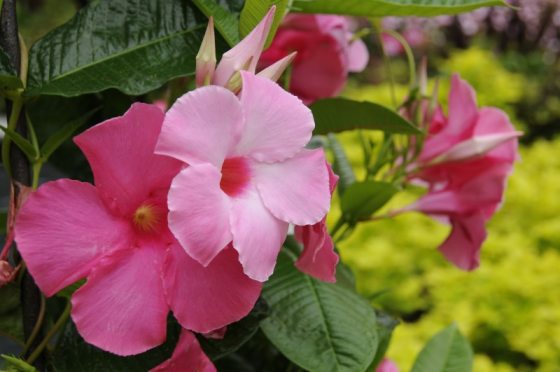
Obtained from the Mitchel Estate in Oyster Bay, NY, in the mid 1930s, this plant was originally grown at Longwood Gardens as Dipladenia x amoena. In the mid 1950s, Dr. Donald Huttleston, Longwood’s Taxonomist, determined that this name might be incorrect. He sent samples to Dr. Robert E. Woodson, Jr., at the Missouri Botanic Garden in St. Louis for examination. Dr. Woodson identified the plant as Mandevilla splendens. Dr. Huttleston noticed that there was variation in the flowers of seedlings. In 1960, he studied some seedlings and found that they showed hybrid characteristics. Dr. Huttleston named this Mandevilla hybrid ‘Alice du Pont’ in honor of the wife of the creator of Longwood Gardens. This vibrant pink-flowered vine can be found throughout the Gardens in summer.
Longwood Cultivars
- Acer platanoides ‘Stand Fast’
- Asparagus densiflorus ‘Myers’
- Asparagus densiflorus ‘Sprengeri’
- Aster tataricus ‘Jindai’
- Buxus sempervirens ‘Longwood’
- Buxus sempervirens ‘Belleville’
- Camellia japonica ‘Longwood Centennial’
- Camellia japonica ‘Longwood Valentine’
- Camellia x williamsii ‘Aida’
- Canna ‘Albatross’
- Canna ‘Beacon’
- Canna ‘Bounty’
- Canna ‘Brandywine’
- Canna ‘Calypso’
- Canna ‘Challenger’ (‘Delaware’)
- Canna ‘Chesapeake’
- Canna ‘Conestoga’
- Canna ‘Declaration’
- Canna ‘Endeavour’
- Canna ‘Erebus’
- Canna ‘Glomar’
- Canna ‘Lenape’
- Canna ‘Liberty’
- Canna ‘Loma’
- Canna ‘Longwood Coral Pink’
- Canna ‘Longwood Crimson’
- Canna ‘Longwood Rose Pink’ (‘Liberty’)
- Canna ‘Longwood White’
- Canna ‘Longwood Yellow’
- Canna ‘Meteor’
- Canna ‘Mrs. du Pont’ (‘Mrs. Pierre S. du Pont’)
- Canna ‘Penn’
- Canna ‘Ra’
- Canna ‘Taney’
- Canna ‘Tourmaline’
- Canna ‘Triton’
- Cantua ‘Hot Pants’
- Caryopteris incana ‘Blue Billows’
- Caryopteris x clandonensis ‘Longwood Blue’
- Cattleya Alice B. du Pont
- Chlorophytum bichetii ‘Longwood Emerald’
- Chrysanthemum ‘Yellow Jupiter’
- Clivia miniata ‘Sir John Thouron’
- Corylopsis glabrescens ‘Longwood Chimes’
- Euonymus fortunei ‘Longwood’
- Hedera helix ‘Calico’
- Hedera helix ‘Misty’
- Hedera helix ‘Tussie Mussie’
- Hedera helix ‘Variegated Needle’
- Hypericum frondosum ‘Sunburst’
- Hypericum cerastoides ‘Sunspot’
- Ilex opaca ‘Longwood Gardens’
- Ilex serrata ‘Longwood Firefall’
- Ilex x attenuata ‘Longwood Gold’
- Impatiens ‘Acrobat’
- Impatiens ‘Arcade’
- Impatiens ‘Arcaoe’
- Impatiens ‘Ballerina’
- Impatiens ‘Bandwagon’
- Impatiens ‘Big Top’
- Impatiens ‘Bozo’
- Impatiens ‘Calliope’
- Impatiens ‘Cannon Ball’
- Impatiens ‘Carnival’
- Impatiens ‘Carousel’
- Impatiens ‘Chariot’
- Impatiens ‘Charmer’
- Impatiens ‘Cotton Candy’
- Impatiens ‘Dancer’
- Impatiens ‘Drummer’
- Impatiens ‘Firecracker’
- Impatiens ‘Fortune Teller’
- Impatiens ‘Gladiator’
- Impatiens ‘Harlequin’
- Impatiens ‘Headliner’
- Impatiens ‘High Wire’
- Impatiens ‘Hurdy-Gurdy’
- Impatiens ‘Jester’
- Impatiens ‘Joey’
- Impatiens ‘Juggler’
- Impatiens ‘Jumbo’
- Impatiens ‘Lollipop’
- Impatiens ‘Magician’
- Impatiens ‘Majorette’
- Impatiens ‘Midway’
- Impatiens ‘Orange Crush’
- Impatiens ‘Painted Lady’
- Impatiens ‘Parade’
- Impatiens ‘Pink Lemonade’
- Impatiens ‘Popcorn’
- Impatiens ‘Popsicle’
- Impatiens ‘Rainbow’ (‘Roller Coaster’)
- Impatiens ‘Ring Master’
- Impatiens ‘Ring Master Improved’
- Impatiens ‘Roustabout’
- Impatiens ‘Showboat’
- Impatiens ‘Skyrocket’
- Impatiens ‘Stop Light’
- Impatiens ‘Torch’
- Impatiens ‘Trapeze’
- Kohleria ‘Longwood’
- Laeliocattleya g. Longwood Gardens
- Magnolia acuminata var. subcordata ‘Peirce's Park’
- Mandevilla ‘Alice du Pont’
- Miscanthus sinenesis ‘Mt. Washington’
- Nymphaea ‘Antares’
- Nymphaea ‘Aquarius’
- Pennisetum macrostachyum ‘Burgundy Giant’
- Penstemon ‘Crystal’
- Petunia ‘DuPont’
- Petunia ‘Longwood’
- Platycerium willinckii ‘Longwood Gardens’
- Plectranthus argentatus ‘Longwood Silver’
- Rhododendron ‘Longwood’
- Rhododendron ‘Pierre du Pont’
- Rosa ‘Mrs. Pierre S. du Pont’
- Sedum hybridum ‘Weihenstephaner Gold’
- Silene ‘Longwood’
- Sorbus rufoferruginea ‘Longwood Sunset’
- Tecomaria ‘Eland’
- Tecomaria ‘Gazelle’
- Tecomaria ‘Gerenuk’
- Tecomaria ‘Impala’
- Tecomaria ‘Kongoni’
- Tecomaria ‘Roan’
- Tecomaria ‘Sable’
- Viburnum nudum ‘Longwood’
- Victoria ‘Longwood Hybrid’
- Wisteria frutescens ‘Longwood Purple’
